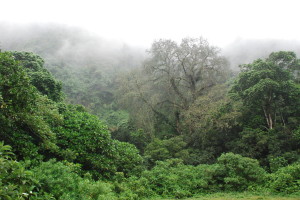Overview
Adequate incorporation of land cover in global and regional climate models is still one of the major priorities in the climate modeling community. In particular, anthropogenic land cover change (ALCC) is still not successfully implemented in these models. As a result, climate modeling in paleo-mode or projection mode that tries to take ALCC into account is seriously hampered (Strandberg et al., 2014).
This is due to the fact that:
i) the dynamic vegetation models coupled to global climate models (GCMs) or regional climate models (RCMs) simulate climate-induced vegetation (i.e. potential, natural vegetation) but cannot yet simulate anthropogenic vegetation, and
ii) the scenarios of past ALCC, e.g. HYDE (Klein Goldewijk et al., 2011), KK (Kaplan et al., 2009) and others, show very large differences (Gaillard et al., 2010).
 The cultural landscape of the Shandong province, China, with abandoned terraces, cultivated terraces, and pine woods. Area of an ongoing study of the pollen productivity of herbs as indicators of human land use (Li, Gaillard et al.). Credit: M-J Gaillard, Oct 2014. |
The question of whether humans had more impact on climate in prehistory (from 3k BP or earlier) than previously assumed, is still a matter of debate. Thus, the effect of anthropogenic burning and deforestation on global climate via biogeochemical and biogeophysical processes in the past is not fully understood yet, and mitigation strategies using e.g. tree plantations to create CO2 sinks and climate cooling might be erroneous. Improved descriptions of past anthropogenic land cover change at the global spatial scale are therefore needed.
LandCover6k addresses land-cover change across the globe that is climate-induced, natural, AND human-induced due to anthropogenic land use from ca. 1-2 millenia before the start of agriculture. The start of agriculture is dated to ca. 6000 calendar years BP in Europe, but is significantly older in East Asia, e.g. in China at ca. 8000 cal. years BP. Therefore, LandCover6k’s efforts are NOT restricted to the last 6000 cal. years, but will cover the last ca. 10000 cal. years However, the time of most significant deforestation globally is assumed to start at ca. 4000 cal. years ago in East Asia and ca. 3000 cal. years ago in Europe.
LandCover6k builds upon, and expands, the pollen-based reconstruction work of PAGES’ Focus 4 theme, Land Use and Cover. It brings together paleoecologists, historians, archeologists, and modelers to explore and provide new information about ALCC. It aims to create products suitable for climate modelers and climate change policy makers.
Expected products
The planned products of LandCover6k are:
Product A: Largely improved HYDE and KK models for the Holocene using land-use and land-cover reconstructions from paleoecological data and historical/archeological data (Products B below)
Product B: Land-cover and land-use maps for time windows and/or periods of the Holocene.
Land Cover and Land Use represent the two activities of LandCover6k, these are defined as follows:
Land cover = vegetation cover
Land use = categories of land-use systems inferred from archeological and historical data (with the complement of paleoecological data, e.g. pollen and plant macrofossils, phytoliths etc.)
The Land Cover and Land Use products (in B above) will be integrated and used to achieve product A above.
Phase 1
Phase 1 (2015-2017) of the working group will focus on the following activities and products for three priority time windows of the Holocene: 6k, 0.45k (AD 1500), and 0.1k cal. BP (AD 1850):
– Pollen-based land-cover reconstructions / maps from key regions of all continents
– Global land-use maps based on archeological and historical data
– First revision of ALCC (Anthropogenic Land-Cover Change) scenarios (KK and HYDE)
Learn more and participate
Subscribe to the LandCover6k mailing list here.
This group is open to anyone who is interested, to participate contact the Coordinator.
News
Seeking historians and archeologists
(Published: May 2015)
LandCover6k needs more historians and archeologists willing to collaborate with paleoecologists and help with reconstruction of historical and prehistorical deforestation by humans on Earth in quantitative terms. If interested, please email the Land-Use Coordinator.
Upcoming LandCover6k meetings and sessions around the world
(Published: May 2015)
1. INQUA, Nagoya, Japan July 26th-August 2nd 2015. The LandCover6k WG will meet in collaboration with the two INQUA commissions HAB COMM and PAL COMM on Tuesday 28th July, at Lunchtime. Venue: Room number 231. Responsible organizer: Ralph Fyfe (ralph.fyfe@plymouth.ac.uk). Contact him for further information or Kathleen Morrison and Nicki Whitehouse.
2. Training course/workshop: Pollen source area theory, modeling pollen-vegetation relationships, and dealing with reconstruction uncertainty, 7-12th September 2015, Centre for Past Climate Change, University of Reading, UK. Contact: Sandra Patricia Harrison s.p.harrison@reading.ac.uk]
3. Workshop on global land-use classification from 21-22 October 2015 at the University of Chicago Center in Paris. Responsible organizer: Kathleen Morrison (morrison@uchicago.edu). Contact her for further information.
4. Workshop on Land-use and Land-cover change in Eastern Africa. Two-day workshop at the British Institute in Eastern Africa and the National Museums of Kenya on the 22nd and 23rd October. The workshop, organised by Rob Marchant (University of York; robert.marchant@york.ac.uk) and Stephen Rucina (National Museums of Kenya) will bring together archaeologists, palaeoecologists, historians, ecosystem and climate modellers focused on working in East Africa. The workshop will bring together material evidence from across the Eastern African region to develop a synthesis of regional land cover change that will feed into the wider LandCover6K project.
5. AGU San Francisco December 14-18th 2015: LandCover6k will be present at the conference within sessions coordinated by IGBP. Abstracts are now welcomed. Read more here.


